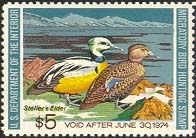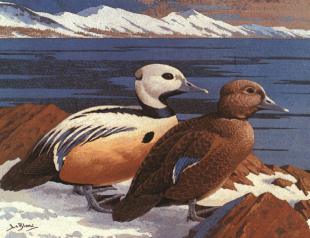

Back to RW40 Back to the Federal Index Home
A LITTLE HISTORY ON THE 40TH (1973-74) DUCK STAMP ARTIST


Lee LeBlanc was born on October 5, 1913. When he graduated from high school in Iron River, Michigan, he went to the Frank Wiggins Trade School in Los Angeles and spent a year studying art. Hoping to find work as a commercial artist, he left Los Angeles and headed for New York. It took him only three weeks to decide that New York wasn’t for him. He ended up taking more art lessons in Philadelphia, tending bar to cover expenses at the LaFrance Art Institute. He then decided to try his luck in New York again and this time did better than bartending. He landed a job as a staff illustrator for the New York Journal. He continued to study art, attending the Art Students League, where he studied under Will Foster.
It was back to Los Angeles in 1937 where he worked with Western Lithography as a commercial artist. Although he had the skill, his heart wasn’t in his work and he joined Walt Disney’s staff six months later at the salary of $10 a week. It didn’t take much to get him to the cartoon firm of Looney Tunes with an offer of higher pay.
But even a job he enjoyed could not always make life happy for Mr. LeBlanc. When his wife, Helene, lost the fight against a long-term illness, in 1955, he was left to raise 14-year-old daughter Dierdre. Whenever he felt the pressures of Los Angeles and the motion picture industry getting to him, he would pack some fishing gear and, with his daughter, head back to the Michigan wilderness he loved so much. It was on one of these trips that he met and later married Lucille Hayworth.
By this time, Mr. LeBlanc had worked his way up to administrator of the special effects photographic department for MGM Studios. After six years, he began to get fed up with the pressures of Los Angeles and the motion picture industry getting to him, he would pack some fishing gear and, with his daughter, head back to the Michigan wilderness he loved so much. It was on one of these trips that he met and later married Lucille Hayworth.
By this time, Mr. LeBlanc had worked his way up to administrator of the special effects photographic department for MGM Studios. After six years, he began to get fed up with the pressures of tight budgets, impossible schedules, and television competition. In 1962, he leaned back and realized, as he puts it, "There just had to be a better way to make a living." Leaving the security of his job at MGM, he headed back to the only place he could really call home, Iron River.
At their home, the LeBlancs enjoyed a close, genuine relationship with nature. They made no attempt to tame any of their wild friends, and fed many animals and birds all year ‘round. They traveled to one or more of the nation’s wildlife refuges each year.
Mr. LeBlanc died on July 21, 1988 in Iron River, Michigan
--------------------THE ART--------------------
Steller’s Eiders was painted in full color opaque watercolor. The print was by photolithography, four-color process printed on Curtis Stoneridge paper. The edition is 1,000 prints signed in pencil and numbered, with 50 artist and 50 printer’s proofs. The image size of the print is 6-1/2" x 9".
--------------------THE STAMP--------------------
Steller’s Eiders…Engraved by the Federal Bureau of Engraving from the original artwork. Printed in yellow, brown, blue, grey, dark brown, light brown and black ink. The stamp sold for five dollars. Postal records show 2,113,594 stamps sold. The first day of sale was July 1, 1973.
Most of the information contained above is from the book Federal Duck Stamp Story, Fifty Years of Excellence, by Laurence F. Jonson; Alexander & Co. It is used here with permission from the author. For more information on this book, please click here.